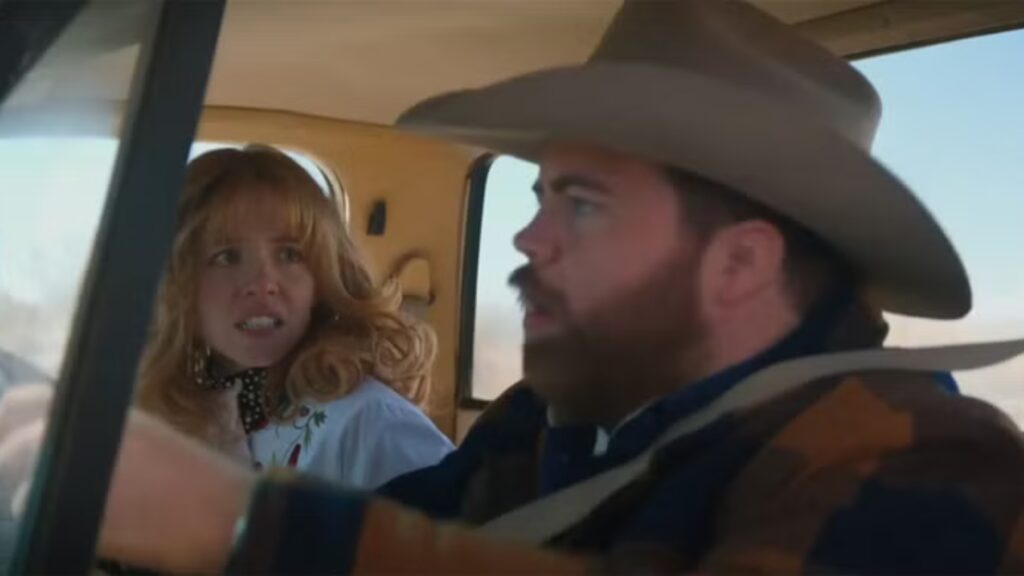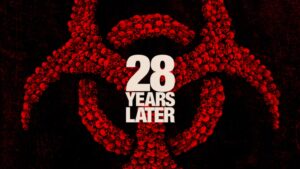Quick Facts & Overview.
Title: Americana (2025 theatrical release of a 2023 film)
Director / Writer: Tony Tost (feature directorial debut)
Genre: Neo-Western / crime thriller / ensemble chase drama
Runtime: ~107 minutes
Production / Budget: ~$9 million (according to its earlier profile)
Box Office / Gross: The film has modest box office outcomes reported; some numbers list ~$500,000 worldwide in theatrical gross
Release & Festivals: Americana premiered at South by Southwest in March 2023. It was theatrically released by Lionsgate on August 15, 2025.
Critical Reception: Mixed to average reviews; praise for ambition, cast, grit, but criticisms around pacing and character coherence.
Cast — How Many & Who Are the Principals.
The cast is ensemble-driven, with multiple intersecting storylines. Key cast members (with significant roles) include:
- Sydney Sweeney as Penny Jo Poplin
- Paul Walter Hauser as Lefty Ledbetter
- Halsey as Mandy Starr
- Eric Dane as Dillon MacIntosh
- Simon Rex as Roy Lee Dean
- Zahn McClarnon as Ghost Eye
- Other supporting cast: Gavin Maddox Bergman (Cal Starr)nDerek Hinkey (Hank Spears) Toby Huss (Pendleton Duvall) Harriet Sansom Harris (Tish) Donald Cerrone (Sheriff Cole Pickering)
In total, counting leads and meaningful supporting roles, you’d estimate around 10 to 12 principal actors.
Who is the Means Character / Center of the Americana Movie Story?
Because Americana is an ensemble crime drama, there isn’t a single clear “means character” in the classical sense (one protagonist through whose eyes the entire story unfolds). However, Penny Jo Poplin (Sydney Sweeney) stands out as a key focal point: she is introduced as a shy waitress with big dreams whose life becomes entangled when a rare Native American artifact appears on the black market. Her pursuit of that artifact, her alliances, and the consequences she faces make her one of the emotional and narrative centers.
Another strong figure is Lefty Ledbetter (Paul Walter Hauser), the veteran who partners with her. Their alliance forms a spine for the plot’s chase and conflict. But the film’s nature — intersecting stories of outsiders, criminals, indigenous stakeholders — means that the narrative shares focus among multiple character arcs rather than being dominated by just one.
Box Collection / Financial Performance.
- The theatrical gross is modest. According to one source, the global theatrical gross is about $500,000 (in limited release)
- The Numbers listing is incomplete; it reports “Domestic Box Office | n/a” for Americana, indicating that the theatrical performance is either not fully disclosed or minimal in scale.
- Earlier articles sometimes cite the figure of ~$500,000 for its opening weekend or initial box office run.
- Given its modest budget (~$9 million) and limited theatrical exposure, it’s unlikely Americana recouped much of its cost through theaters alone; its financial strategy likely anticipated revenue from streaming, digital, and ancillary rights.
Thus, in pure box office terms, Americana is a small performer — but that is expected for an indie crime/neo-Western with niche appeal.
The Niche / What Kind of Film Is Americana
Americana sits firmly in a niche of modern / neo-Westerns with crime thriller elements, an ensemble cast, and moral crosswinds as multiple parties chase a culturally loaded artifact. Some features of its niche:
- Neo-Western crime drama: It updates the Western’s frontier conflicts to modern times, with artifacts, greed, and cultural appropriation as battlefields.
- Ensemble chase / MacGuffin plot: Many characters—with their own motives, secrets, agendas—converge over possession of a valuable Lakota object (a “Ghost Shirt”) that passes through black market channels.
- Outsiders and cultural collision: The film pries into external vs internal identities: people from outside the region, indigenous groups, criminals, and locals all collide.
- Stylized grit, quirk, and moral ambiguity: It leans into eccentric characters, dialogue flourishes, and moral complexity rather than black-and-white heroism.
If your interests are modern Westerns, ensemble crime dramas, or morally messy storytelling in rural America, Americana is squarely in that lane.

Deep Dive — Plot, Themes, Strengths & Weaknesses.
Plot (spoiler-light summary)
The story begins with a rare Lakota Ghost Shirt (a culturally significant Native American relic) entering the black market. From there, a collection of characters’ lives intersect violently. Penny Jo Poplin (Sweeney) is a waitress with big dreams who crosses paths with Lefty Ledbetter (Hauser), a military veteran. They team up to attempt recovery of the artifact. Meanwhile, Eric Dane’s Dillon MacIntosh is the enforcer working for an antiquities dealer (Simon Rex’s Roy Lee Dean). Other claimants include an Indigenous leader (Ghost Eye, played by Zahn McClarnon) and Mandy (Halsey), a woman with a mysterious past. The pursuit escalates across South Dakota landscapes, clashes erupt, betrayals surface, and price is paid.
The film is built in chapters or shifting perspectives; characters’ backstories gradually reveal regrets, allegiances, and why the artifact means so much beyond mere monetary value.
By the climax, multiple confrontations converge — shootouts, moral reckoning, and sacrifices give the chase emotional stakes, not just action.
Themes & Meanings
Cultural restitution vs exploitation
The artifact is not just a treasure for theft — it carries deep cultural and spiritual weight. The film uses the artifact’s journey to explore who has rights over cultural heritage, what historical wrongs continue, and how outsiders profit from indigenous artifacts.
Greed, ambition & moral cost
Many characters are not purely villainous — they have reasons, dreams, debts. The film asks: at what cost do ambitions and survival cross into cruelty? The artifact becomes a temptation that reveals character.
Outsider identity & place
Penny Jo is a “local outsider” — someone striving for more in a place where options are thin. Lefty as a veteran has his own dislocation. Ghost Eye evokes Indigenous presence, ancestral weight, and the tension between connection to land vs exploitation by others.
Violence & the mythic West
Americana engages Western tropes — shootouts, open landscape, moral duels — but filters them through a modern lens: sacred relics, black markets, overlapping claims, blurred justice. Violence is messy and immoral rather than romantic.
Intersecting fates & moral complexity
Because the Americana film is ensemble in structure, no one character is purely good or evil. The shifting alliances, betrayals, and reversals make the film’s moral structure dynamic rather than static.
Strengths — what Americana does well
- Ambitious scope / audacity
For a first feature, Tony Tost attempts a complex web of characters, cultural stakes, and a modern Western structure. The fact the film tries to juggle artifact lore, crime, personal motivations, and cultural commentary is ambitious. - Strong casting and performances
The ensemble cast is often cited as a redeeming quality. Zahn McClarnon and Halsey, in particular, are praised by critics for bringing emotional weight. - Atmospheric setting & visuals
The landscapes, the small town feel, dust and horizon, and shifting desert/field motifs give it a West-tinged atmosphere. The visuals often lean into the wide space of morality. - Gallows humor, stylized violence & quirk
Some critics note it has a quirky edge — chapter structure, eccentric character flourishes, violence that is bloody and sudden — giving the film energy beyond straight genre.
Weaknesses & Critiques
- Pacing & coherence issues
A recurring criticism is that the film feels overstuffed or underbalanced: too many characters, shifting perspectives, sometimes unclear motivations. Some threads feel underdeveloped. - Character depth unequal
While lead arcs are more fleshed out, many supporting players are more sketches than fully realized individuals. Some decisions feel made for plot necessity rather than organic character logic. - Box office underperformance relative to ambition
Given its budget and ensemble, the theatrical take is modest. That’s typical for niche films, but against ambitious goals it’s a limitation. - Tonal inconsistency
The blend of quirk, violence, mythic weight, and ensemble drama sometimes jars. Scenes intended as humor or character moment might clash with harshness of plot.
Reception Snapshot & Critic Consensus.
Metacritic calls the film “charming, gritty, and all-round entertaining” with gallows humor and compelling performances, while noting it doesn’t revolutionize the Western genre.
Plugged In domain notes it as a “quirky neo-Western” with heavy profanity and bloody violence, and praises the actors’ performances even if the story is messy.
Some festival reviews (e.g. SXSW commentary) praise that the film breaks Western expectations and interweaves memorable characters.
However, more critical voices (e.g. reviews in mainstream outlets) point to weak plotting, underwritten characters, and style over substance.
Verdict & Advice for Viewers.
Americana is not a perfect film, but its virtues lie in its ambition, its willingness to blend cultural weight with crime drama, and its ensemble cast taking on morally murky terrain. It’s a flawed but interesting piece of modern Western storytelling.
If you should watch it:
- If you like neo-Westerns that twist the old tropes into modern crime stories
- If you enjoy ensemble casts with intersecting arcs and morally ambiguous motives
- If you appreciate atmospheric, gritty filmmaking over clean narrative seams
You might hold off if:
- You prefer tightly plotted stories with minimal loose ends
- You dislike sudden tonal swings or underdeveloped characters
- You expect blockbuster returns or fully resolved arcs





